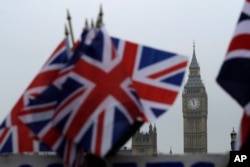After years of stagnation and high unemployment, the eurozone countries appear to be bouncing back with growth in the shared currency bloc, soaring higher than in the United States and Britain.
The eurozone grew at an annual rate of 1.7 percent during the first three months of 2017, while the bloc’s trade surplus doubled in March from the previous month. Unemployment is falling, albeit still stubbornly high at 9.6 percent.
“For a change, Europe is leading this upswing. It’s partly because of the connection between Europe and China, demand from China. But at the same time, we have also some domestic factors which are positive: there is a genuine improvement in domestic demand, particularly consumption. So the recovery is broad-based, and is more sustainable than in the past,” said analyst Lorenzo Codogno of LC Macro Advisors, also a visiting professor at the London School of Economics.
Some of the economies that suffered most in the 2008 debt crisis are bouncing back strongest — the so-called PIGS. Portugal hit a 10-year high with 2.8 percent year-on-year growth. Spain’s economy is forecast to grow 2.7 percent in 2017, and passed a crucial milestone last month as its GDP exceeded pre-2008 crisis levels.
“We’re seeing a cyclical recovery because we finally had the European Central Bank operating like a normal central bank and doing quantitative easing,” says analyst John Springford of the Center for European Reform.
With inflation in the eurozone hitting the central bank’s target of 1.9 percent, many economists expect the quantitative easing program to keep interest rates low to be wound down later this year. There are fears, however, that turning off the money could hurt the eurozone’s poorest performers.
Italy’s economy is still in the slow lane with annualized growth of just .8 percent.
“It’s growing very slowly, its banks still haven’t been sorted out and there’s a lot of political instability,” says Springford.
Meanwhile, Greece is back in recession and the familiar public sector strikes have paralyzed transport systems this week. Police joined the protesters over proposed cuts to in-work benefits and pensions. The government plans further cuts in return for the next tranche of EU bailout money. A decision by EU finance ministers is due Monday.
Economist Codogno says the structural problems underpinning the eurozone have not gone away.
“The eurozone cannot survive without additional major reforms, which means more integration, in terms of fiscal and eventually even political.”
Overshadowing the bounce-back is Brexit. Britain’s decision to leave the EU is weighing on its economy as growth slows and wages fall, says Springford.
“The pain is going to be largely borne on the UK side because it’s a smaller economy. The big question is whether the EU and the UK can negotiate a deal which minimizes the economic costs. And we’ve had a very bad start to negotiations with a lot of bad blood.”
Europe’s politicians hope economic growth can help stop the march of anti-EU populism that saw Britain vote to leave the bloc.
The election of pro-EU centrist Emmanuel Macron as French president has reinvigorated the French-German axis that has long been the eurozone’s driving force. Macron’s political honeymoon could be short, with French unions already voicing objections to his proposed reforms.












